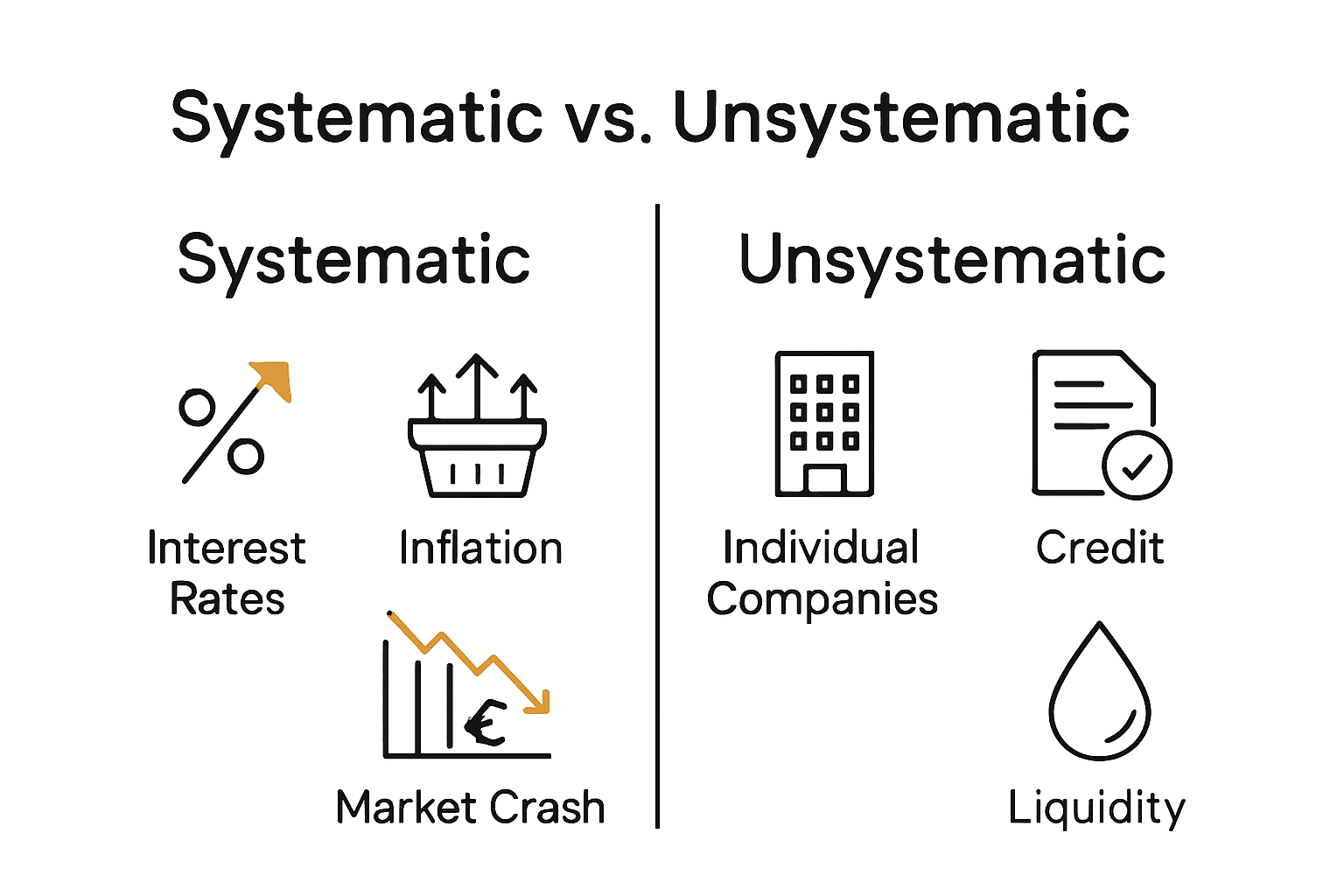Nearly 40 percent of investors say they worry most about losing money when the markets shift without warning. Managing investment risk matters now more than ever as economic swings and global events increase financial uncertainty. Understanding how to spot, measure, and address these threats can help anyone build a stronger, more secure investment plan that stands up to the unexpected.
Table of Contents
- What Is Investment Risk Management
- Types Of Investment Risks Explained
- Assessing And Measuring Risk Accurately
- Investment Risk Mitigation Strategies
- Regulatory And Compliance Risk Considerations
Key Takeaways
| Point | Details |
|---|---|
| Investment Risk Management | A strategic framework to identify, assess, and mitigate potential financial losses in investment portfolios. |
| Types of Risks | Investment risks are classified into systematic (market-wide) and unsystematic (specific to individual investments) categories. |
| Risk Assessment Techniques | Advanced data-driven methods, such as Value-at-Risk and Beta Analysis, improve the accuracy of risk assessment. |
| Mitigation Strategies | Implementing diversification, hedging, and asset allocation can effectively minimize potential investment risks. |
What Is Investment Risk Management
Investment risk management represents a strategic approach designed to identify, assess, and mitigate potential financial losses within investment portfolios. According to Oxford Academic, it is a comprehensive framework that helps investors understand and navigate the complex landscape of potential investment uncertainties.
At its core, investment risk management involves several critical components. As detailed by Kent Baker and Greg Filbeck, these typically include:
- Identifying potential risks: Recognizing various financial threats that could impact investment performance
- Quantifying risk exposure: Measuring the potential magnitude of potential losses
- Developing mitigation strategies: Creating targeted approaches to minimize potential negative outcomes
- Continuous monitoring: Regularly evaluating investment performance and risk indicators
The fundamental purpose of investment risk management goes beyond mere protection. It enables investors to make informed decisions by understanding the potential downsides of their investment choices. Academic Research suggests that effective risk management is particularly crucial during periods of environmental uncertainty, where traditional investment models may become less predictable.
By systematically analyzing potential risks and implementing strategic safeguards, investors can create more resilient portfolios that balance potential returns with measured risk tolerance. This approach transforms risk from an abstract concept into a manageable aspect of investment strategy, allowing for more confident and strategic financial decision-making.
Types Of Investment Risks Explained
Investment risks are multifaceted challenges that can potentially impact financial performance. Bcom Institute categorizes these risks into two primary classifications: systematic and unsystematic risks, which provide a fundamental framework for understanding potential investment threats.
Systematic risks, often called market risks, are broad economic factors that universally impact all investments. These include:
- Interest rate risk: Changes in market interest rates affecting investment values
- Inflation risk: Potential loss of purchasing power due to economic currency devaluation
- Political risk: Government policy changes that could impact financial markets
- Currency risk: Fluctuations in exchange rates affecting international investments
Unsystematic risks, by contrast, are specific to individual companies or sectors. According to IJITEE Research, these risks are unique to particular investments and can be mitigated through strategic diversification. Such risks might include:

- Business risk: Company-specific challenges affecting financial performance
- Credit risk: Potential for default by borrowers or investment counterparties
- Liquidity risk: Difficulty in converting investments to cash without significant value loss
Understanding these risk types empowers investors to develop more nuanced risk tolerance strategies.
 By recognizing that not all risks are equal and some can be managed more effectively than others, investors can make more informed decisions that balance potential returns with comprehensive risk management.
By recognizing that not all risks are equal and some can be managed more effectively than others, investors can make more informed decisions that balance potential returns with comprehensive risk management.
Assessing And Measuring Risk Accurately
Risk assessment is a sophisticated process that transforms complex financial uncertainty into measurable insights. ArXiv Research highlights the emerging importance of advanced data-driven approaches in portfolio risk management, emphasizing the need for dynamic and comprehensive measurement techniques.
Investors typically employ multiple quantitative methods to assess investment risks accurately:
- Standard Deviation: Measuring the volatility of investment returns
- Beta Analysis: Evaluating an investment’s sensitivity to market fluctuations
- Value-at-Risk (VaR): Calculating potential maximum loss within a specific confidence interval
- Sharpe Ratio: Comparing investment returns against potential risks
Advanced Research suggests that implementing mean-variance portfolio strategies with precise risk constraints can significantly enhance investment decision-making. These approaches allow investors to optimize their portfolios by explicitly managing potential downside risks while maintaining targeted return expectations.
Modern risk assessment goes beyond traditional statistical models. By integrating big data analytics, machine learning algorithms, and sophisticated financial modeling, investors can develop more nuanced and predictive risk measurement frameworks. This approach transforms risk from a static calculation into a dynamic, continuously evolving understanding of potential financial challenges.
Investment Risk Mitigation Strategies
Investment risk mitigation represents a proactive approach to protecting portfolio value through strategic planning and sophisticated techniques. ArXiv Research introduces risk parity as a revolutionary method for balancing risk across different asset classes, ensuring no single investment type dominates potential losses.
Key risk mitigation strategies include:
- Diversification: Spreading investments across multiple asset classes and sectors
- Hedging: Using financial instruments to offset potential negative market movements
- Asset Allocation: Strategically balancing portfolio components based on risk tolerance
- Periodic Rebalancing: Regularly adjusting portfolio composition to maintain desired risk levels
Advanced Financial Research highlights the critical importance of understanding tail risks, which represent extreme market volatility scenarios that can dramatically impact investment performance. By developing comprehensive asset allocation strategies, investors can create more resilient portfolios capable of withstanding unexpected market disruptions.
Successful risk mitigation is not about eliminating risk entirely, but about managing and minimizing potential negative outcomes. This approach transforms uncertainty from a threat into a calculated component of strategic investment decision-making, enabling investors to pursue growth while maintaining a robust defensive posture.
Regulatory And Compliance Risk Considerations
Regulatory compliance represents a critical dimension of comprehensive investment risk management that extends far beyond traditional financial analysis. Policy Uncertainty Research highlights how unpredictable government policies can significantly impact investment strategies, creating complex layers of potential financial risk.
Key regulatory and compliance risk considerations include:
- Legal Framework Monitoring: Tracking changes in financial regulations
- Reporting Transparency: Maintaining accurate and timely disclosure of investment activities
- Governance Standards: Adhering to established ethical and professional guidelines
- Regulatory Adaptation: Developing flexible strategies to accommodate evolving legal landscapes
Operational Due Diligence Research emphasizes the importance of comprehensive investigation into potential compliance vulnerabilities. Financial Risk Management Strategies become essential in navigating these complex regulatory environments, ensuring investors can proactively identify and mitigate potential legal and financial risks.
Successful regulatory risk management requires a proactive, dynamic approach that combines continuous learning, strategic planning, and robust internal control mechanisms. By treating compliance not as a static requirement but as an integral part of investment strategy, investors can transform potential regulatory challenges into opportunities for enhanced financial performance and risk protection.
Master Your Investment Risks with Expert Guidance
Navigating investment risks like market volatility, regulatory changes, and portfolio diversification can feel overwhelming. This guide highlights the critical challenge investors face in managing complex uncertainties that threaten financial growth and security. You need precise strategies to measure risks such as inflation, credit, and liquidity while balancing potential returns against your personal risk tolerance.
At finblog.com, we understand that effective investment risk management is about turning uncertainty into opportunity. Our tailored resources help you develop diversification methods, implement asset allocation tactics, and stay compliant with evolving regulations. Start building robust portfolios with confidence by accessing expert insights and tools designed specifically for serious investors and finance professionals.
Ready to take control of your investment risks today Visit finblog.com for actionable strategies and personalized support that can transform your financial decision making. Don’t wait for market volatility to catch you off guard Begin your path to smarter investing now.
Frequently Asked Questions
What is investment risk management?
Investment risk management is a strategic approach aimed at identifying, assessing, and mitigating potential financial losses within investment portfolios, helping investors navigate uncertainties.
What are the types of investment risks?
Investment risks are classified into two main categories: systematic risks, which affect the entire market (like interest rate and inflation risks), and unsystematic risks, which are specific to individual companies or sectors (such as business and credit risks).
How can I assess and measure investment risk accurately?
You can assess and measure investment risk using methods such as standard deviation, beta analysis, value-at-risk (VaR), and the Sharpe ratio, which provide insights into potential volatility and performance.
What are effective strategies for mitigating investment risk?
Effective risk mitigation strategies include diversification across asset classes, hedging with financial instruments, strategic asset allocation, and periodic rebalancing of your investment portfolio.










